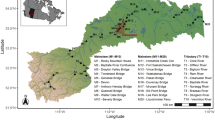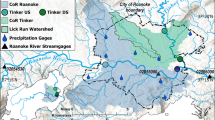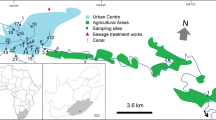Abstract
Water-quality policy documents throughout the world often identify urban stormwater as a large and controllable impact to sensitive ecosystems, yet there is often limited data to characterize concentrations and loads especially for rare and more difficult to quantify pollutants. In response, concentrations of suspended sediments and silver, mercury and selenium including speciation, and other trace elements were measured in dry and wet weather stormwater flow from a 100 % urban watershed near San Francisco. Suspended sediment concentrations ranged between 1.4 and 2700 mg/L and varied with storm intensity. Turbidity was shown to correlate strongly with suspended sediments and most trace elements and was used as a surrogate with regression to estimate concentrations during unsampled periods and to compute loads. Mean suspended sediment yield was 31.5 t/km2/year. Total mercury ranged between 1.4 and 150 ng/L and was, on average, 92 % particulate, 0.9 % methylated, and 1.2 % acid labile. Total mercury yield averaged 5.7 μg/m2/year. Total selenium ranged between non-detect and 2.9 μg/L and, on average, the total load (0.027 μg/m2/year) was 61 % transported in dissolved phase. Selenate (Se(VI)) was the dominant species. Silver concentrations ranged between non-detect and 0.11 μg/L. Concentrations and loads of other trace elements were also highly variable and were generally similar to other urban systems with the exceptions of Ag and As (seldom reported) and Cr and Zn which exhibited concentrations and loads in the upper range of those reported elsewhere. Consistent with the semi-arid climatic setting, >95 % of suspended sediment, 94 % of total Hg, and 85–95 % of all other trace element loads were transported during storm flows with the exception of selenium which showed an inverse relationship between concentration and flow. Treatment of loads is made more challenging in arid climate settings due to low proportions of annual loads and greater dissolved phase during low flow conditions. This dataset fills an important local data gap for highly urban watersheds of San Francisco Bay. The field and interpretative methods, the uniqueness of the analyte list, and resulting information have general applicability for managing pollutant concentrations and loads in urban watersheds in other parts of the world and may have particularly useful application in more arid climates.



Similar content being viewed by others
References
Abrams, M. M., Burau, R. G., & Zasoski, R. J. (1990). Organic selenium distribution in selected California soils. Soil Science Society of America Journal, 54, 979–982.
Anderson, D. W. (1998). Natural levels of nickel, selenium, and arsenic in the south San Francisco Bay area. Report prepared for the City of San Jose. San Jose:Environmental Services Department by the Institute for Research in Environmental Engineering and Science 15 pp.
Asaf, L., Nativ, R., Shain, D., Hassan, M., & Geyer, S. (2004). Controls on the chemical and isotopic compositions of urban stormwater in a semiarid zone. Journal of Hydrology, 294(4), 270–293.
Ashley, P. M., & Napier, M. E. (2005). Heavy-metal loadings related to urban contamination in the Kooloonbung Creek catchment, Port Macquarie, New South Wales. Australian Journal of Earth Sciences, 52(6), 843–862.
Babiarz, C. L., Hurley, J. P., Benoit, J. M., Shafer, M. M., Andren, A. W., & Webb, D. A. (1998). Season influences on partitioning and transport of total and methylmercury in rivers from contrasting watersheds. Biogeochemistry, 41, 237–257.
Babiarz, C., Hoffmann, S., Wieben, A., Hurley, J., Andren, A., Shafer, M., & Armstrong, D. (2012). Watershed and discharge influences on the phase distribution and tributary loading of total mercury and methylmercury into Lake Superior. Environmental Pollution, 161, 299–310.
Balogh, S. J., Huang, Y., Offerman, H. J., Meyer, M. L., & Johnson, D. K. (2003). Methylmercury in rivers draining cultivated watersheds. Science of the Total Environment, 303, 305–313.
Balogh, S. J., Nollet, Y. H., & Offerman, H. J. (2005). A comparison of total mercury and methylmercury export from various Minnesota watersheds. Science of the Total Environment, 340, 261–270.
Beck, H. J., & Birch, G. F. (2012). Metals, nutrients and total suspended solids discharged during different flow conditions in highly urbanised catchments. Environmental Monitoring and Assessment, 184, 637–653.
Bergbäck, B., Johansson, K., & Mohlander, U. (2001). Urban metal flows—a case study of Stockholm. Water, Air, & Soil Pollution: Focus, 1, 3–24.
Birch, G. F., & Rochford, L. (2010). Stormwater metal loading to a well-mixed/stratified estuary (Sydney Estuary, Australia) and management implications. Environmental Monitoring and Assessment, 169, 531–551.
Boulay, N., & Edwards, M. (2000). Copper in the urban water cycle. Critical Reviews in Environmental Science and Technology, 30, 297–326.
Bradford GR, Chang AC, Page AL, Bakhtar D, Frampton JA, Wright H. Background concentrations of trace and major elements in California soils. Kearney Foundation Special Report, University of California, Riverside; 1996. Available from: http://envisci.ucr.edu/downloads/chang/kearney_special_report_1996.pdf
Buffleben, M. S., Zayeed, K., Kimbrough, D., Stenstrom, M. K., & Suffet, I. H. (2002). Evaluation of urban non-point source runoff of hazardous metals entering Santa Monica Bay, California. Water Science and Technology, 45, 263–268.
Burke, M. P., Hogue, T. S., Kinoshita, A., Barco, J., Wessel, C., & Stein, E. D. (2013). Pre- and post-fire pollutant loads in an urban fringe watershed in southern California. Environmental Monitoring and Assessment, 185, 10131–10145.
Characklis, G. W., & Wiesner, M. R. (1997). Particles, metals, and water quality in runoff from large urban watershed. Journal of Environmental Engineering, 123(8), 753–759.
Choe, J. S., Bang, K. W., & Lee, J. H. (2002). Characterization of surface runoff in urban areas. Water Science and Technology, 45, 249–254.
Cloern, J. E., & Jassby, A. D. (2012). Drivers of change in estuarine-coastal ecosystems: discoveries from four decades of study in San Francisco Bay. Reviews of Geophysics, 50, RG4001. doi:10.1029/2012RG000397 33 pp.
Cloern, J. E., Foster, S. Q., & Kleckner, A. E. (2014). Phytoplankton primary production in the world’s estuarine-coastal ecosystems. Biogeosciences, 11, 2477–2501.
Conomos, T. J. (Ed.) (1979). San Francisco Bay: the urbanized estuary. San Francisco:Pacific Division, American Association for the Advancement of Science.
David, N., McKee, L. J., Black, F. J., Flegal, A. R., Conaway, C. H., Schoellhamer, D. H., et al. (2009). Mercury concentrations and loads in a large river system tributary to San Francisco Bay, California. Environmental Science & Technology, 28(10), 2091–2100.
David, N., Gluchowski, D.C, Leatherbarrow, J.E, Yee, D., and McKee, L.J, (2015). Evaluation of loads of mercury, selenium, PCBs, PAHs, PBDEs, dioxins, and organochlorine pesticides from the Sacramento-San Joaquin River Delta to San Francisco Bay. Water Environment Research, 87(4), 334–346.
Davis, A. P., & Burns, M. (1999). Evaluation of lead concentrations in runoff from painted structures. Water Research, 33, 2949–2958.
Davis, A. P., Shokouhian, M., & Ni, S. (2001). Loading estimates of lead, copper, cadmium, and zinc in urban runoff from specific sources. Chemosphere, 44, 997–1009.
Davis, J. A., Hetzel, F., Oram, J. J., & McKee, L. J. (2007). Polychlorinated biphenyls (PCBs) in San Francisco Bay. Environmental Research, 105, 67–86.
Davis, J. A., Yee, D., Grenier, L., McKee, L. J., Greenfield, B. A., Looker, R., Austin, C., Marvin-DePasquale, M., Brodberg, R., & Blum, J. (2012). Reducing methylmercury accumulation in the food webs of San Francisco Bay and its local watersheds. Environmental Research, 119, 3–26.
Domagalski, J. L., & Dileanis, P. D. (2000). Water-quality assessment of the Sacramento River Basin, California—water quality of fixed sites, 1996-1998. U.S. Geological Survey Water-Resources Investigations Report, 2000–4247.
Eckley, C. S., & Branfireun, B. (2008). Mercury mobilization in urban stormwater runoff. Science of the Total Environment, 403, 164–177.
FISP, 2000. Sampling with the US D-95 depth-integrating suspended-sediment sampler. Federal Interagency Sedimentation Project (FISP), Vicksburg, MS 39180–6199. http://water.usgs.gov/fisp/docs/Instructions_US_D-95_000608.pdf
Flegal, A. R., Davis, J. A., Connor, M. S., & Conaway, C. H. (2007). Sources, transport, fate and toxicity of pollutants in the San Francisco Bay estuary. Environmental Research, 105(1), 1–4.
Gallo, E. L., Brooks, P. D., Lohse, K. A., & McLain, J. E. T. (2013). Land cover controls on summer discharge and runoff solution chemistry of semi-arid urban catchments. Journal of Hydrology, 485, 37–53.
Hurley, J., Benoit, J., Babiarz, C., Shafer, M., Andren, A., Sullivan, J., et al. (1995). Influences of watershed characteristics on mercury levels in Wisconsin rivers. Environmental Science & Technology, 29, 1867–1875.
Kayhanian, M., Fruchtman, B. D., Gulliver, J. S., Montanaro, C., Ranieri, E., & Wuertz, S. (2012). Review of highway runoff characteristics: comparative analysis and universal implications. Water Research, 46, 6609–6624.
Lawson, N. M., & Mason, R. P. (2001). Concentration of mercury, methylmercury, cadmium, lead, arsenic, and selenium in the rain and stream water of two contrasting watersheds in western Maryland. Water Research, 35(17), 4039–4052.
Lawson, N. M., Mason, R. P., & Laporte, J. M. (2001). The fate and transport of mercury, methylmercury, and other trace metals in Chesapeake Bay tributaries. Water Research, 35, 501–515.
Lent, M.A. and McKee, L.J., 2011. Development of regional suspended sediment and pollutant load estimates for San Francisco Bay area tributaries using the regional watershed spreadsheet model (RWSM): year 1 progress report. A technical report for the Regional Monitoring Program for Water Quality, Small Tributaries Loading Strategy (STLS). Contribution No. 666. San Francisco Estuary Institute, Richmond, CA. http://www.sfei.org/sites/default/files/RWSM_EMC_Year1_report_FINAL.pdf
Lewis, J. (1996). Turbidity-controlled suspended sediment sampling for runoff-event load estimation. Water Resources Research, 32, 2299–2310.
Line, D. E., Arnold, J. A., Jennings, G. D., & Wu, J. (1996). Water quality of stormwater runoff from ten industrial sites. Water Resources Bulletin, 32, 807–816.
Mahler, B. J., Van Metre, P. C., & Callender, E. (2006). Trends in metals in urban and reference lake sediments across the United States, 1975–2001. Environmental Toxicology and Chemistry, 25, 1698–1709.
Mason, R. P., & Sullivan, K. A. (1998). Mercury and methyl mercury transport through an urban watershed. Water Research, 32, 321–330.
McKee, L. J., Ganju, N. K., & Schoellhamer, D. H. (2006). Estimates of suspended sediment entering San Francisco Bay from the Sacramento and San Joaquin Delta, San Francisco Bay, California. Journal of Hydrology, 323, 335–352.
McKee, L. J., Lewicki, M., Gangu, N. K., & Schoellhamer, D. H. (2013). Comparison of sediment supply to San Francisco Bay from watersheds draining the bay area and the Central Valley of California. Special issue: a multi-discipline approach for understanding sediment transport and geomorphic evolution in an estuarine-coastal system: San Francisco Bay (Guest editors P.L. Barnard, B.E. Jaffe, and D.H. Schoellhamer). Marine Geology, 345, 47–62.
Meade, R. H. (1969). Landward transport of bottom sediments in estuaries of the Atlantic coastal plain. Journal of Sedimentary Petrology, 39, 222–234.
Miller, C. V., Foster, G. D., & Majedi, B. F. (2003). Baseflow and stormflow metal fluxes from two small agricultural catchments in the Coastal Plain of the Chesapeake Bay Basin, United States. Applied Geochemistry, 18, 483–501.
Naik, A. P., & Hammerschmidt, C. R. (2011). Mercury and trace metal partitioning and fluxes in suburban southwest Ohio watersheds. Water Research, 45, 5151–5160.
Nicolau, R., Lucas, Y., Merdy, P., & Raynaud, M. (2012). Base flow and stormwater net fluxes of carbon and trace metals to the Mediterranean Sea by an urbanized small river. Water Research, 46, 6625–6637.
Nixon, S. W., Ammerman, J. W., Atkinson, L. P., Berounsky, V. M., Billen, G., Boicourt, W. C., et al. (1996). The fate of nitrogen and phosphorus at the land-sea interface margin of the North Atlantic Ocean. Biogeochemistry, 35, 141–180.
Old, G. H., Leeks, G. J. L., Packman, J. C., Smith, B. P. G., Lewis, S., Hewitt, E. J., et al. (2003). The impact of a convectional summer rainfall event on river flow and fine sediment transport in a highly urbanised catchment: Bradford, West Yorkshire. Science of the Total Environment, 314–316, 495–512.
Oram, J. J., McKee, L. J., Werme, C. E., Connor, M. S., & Oros, D. R. (2008). A mass budget of PBDEs in San Francisco Bay, California, USA. Environment International, 34, 1137–1147.
Prestes, E. C., dos Ahjos, V. E., Sodré, F. F., & Grassi, M. T. (2006). Copper, lead, and cadmium loads and behavior in urban stormwater runoff in Curitiba, Brazil. Journal of the Brazilian Chemical Society, 17, 53–60.
Quémerais, B., Cossa, D., Rondeau, B., Pham, T. T., Gagnon, P., & Fottin, B. (1999). Sources and fluxes of mercury in the St. Lawrence River. Environmental Science & Technology, 33, 840–849.
Riscassi, A. L., & Scanlon, T. M. (2013). Particulate and dissolved mercury export in streamwater within three mid-Appalachian forested watersheds in the US. Journal of Hydrology, 501, 92–100.
Rule, K. L., Comber, S. D. W., Ross, D., Thornton, A., Makropoulos, C. K., & Rautiu, R. (2006). Diffuse sources of heavy metals entering an urban wastewater catchment. Chemosphere, 63, 64–72.
Ruzycki, E. M., Axler, R. P., Henneck, J. R., Will, N. R., & Host, G. E. (2011). Estimating mercury concentrations and loads from four western Lake Superior watersheds using continuous in-stream turbidity monitoring. Aquatic Ecosystem Health & Management, 14, 422–432.
Sabin, L. D., Lim, J. H., Stolzenbach, K. D., & Schiff, K. C. (2005). Contribution of trace metals from atmospheric deposition to stormwater runoff in a small impervious urban catchment. Water Research, 39, 3929–3937.
Schäfer, J., Blanc, G., Audry, S., Cossa, D., & Bossy, C. (2006). Mercury in the Lot–Garonne River system (France): sources, fluxes and anthropogenic component. Applied Geochemistry, 21, 515–527.
Schiff, K. C., & Tiefenthaler, L. L. (2011). Seasonal flushing of pollutant concentrations and loads in urban stormwater. Journal of the American Water Resources Association, 47, 136–141.
Sörme, L., Bergbäck, B., & Lohm, U. (2001). Century perspective of heavy metal use in urban areas: a case study in Stockholm. Water, Air, & Soil Pollution: Focus, 1(3–4), 197–211.
Steding, D. J., & Flegal, A. R. (2002). Mercury concentrations in coastal California precipitation: evidence of local and trans-Pacific fluxes of mercury to North America. Journal of Geophysical Research, 107, 4764.
Taylor, K. G., & Owens, P. N. (2009). Sediments in urban river basins: a review of sediment–contaminant dynamics in an environmental system conditioned by human activities. Journal of Soils and Sediments, 9, 281–303.
U.S. Census Bureau (2010). Census Interactive Population Search. http://www.census.gov/ Accessed 28 Nov 2011.
U.S. Environmental Protection Agency (1996). Method for sampling ambient water for determination of metals at EPA ambient criteria levels. US Environ Prot Agency report EPA/821/B-96/001.
Valtanen, M., Sillanpaa, N., & Setala, H. (2014). The effects of urbanization on runoff pollutant concentrations, loadings and their seasonal patterns under cold climate. Water, Air, and Soil Pollution, 225.
Wall, G. R., Ingleston, H. H., & Litten, S. (2005). Calculating mercury loading to the tidal Hudson River, New York, using rating curve and surrogate methodologies. Water, Air, and Soil Pollution, 165, 233–248.
Walling, D. E., & Webb, B. W. (1985). Estimating the discharge of contaminants to coastal waters by rivers: some cautionary comments. Marine Pollution Bulletin, 16, 488–492.
Water Board, 2006. Mercury in San Francisco Bay: proposed basin plan amendment and staff report for revised total maximum daily load (TMDL) and proposed mercury water quality objectives. Oakland (CA): California Regional Water Quality Control Board, San Francisco Bay Region 2. Accessed September 28, 2011 http://www.swrcb.ca.gov/rwqcb2/water_issues/programs/TMDLs/sfbaymercury/sr080906.pdf
Zgheib, S., Moilleron, R., & Chebbo, G. (2011). Influence of the land use pattern on the concentrations and fluxes of priority pollutants in urban stormwater. Water Science and Technology, 64, 1450–1458.
Acknowledgments
We thank Alameda County Flood Control and Water Conservation District and Public Works Agency for site access; Rand Eads, Jon Leatherbarrow (deceased August 6, 2010), Rachel Allen, Nicole David, Jennifer Hunt, Kat Ridolfi, Sarah Pearce, Ben Greenfield, and Katie Harrold for the field assistance during often inclement weather conditions; and the staff of Moss Landing Marine Laboratories and Brooks Rand Laboratories for their diligent production of high-quality data. We thank the Data Management Group at SFEI, particularly Cristina Grosso, Don Yee, John Ross, and Amy Franz. We are indebted to Barbara Mahler, James Kuwabara, Greg Shellenberger, and Peter Mangarella for early reviews of field procedures and draft reports and several anonymous reviewers who provided a framework for improvements to the manuscript. Funding was provided by the San Francisco Bay Regional Monitoring Program for Water Quality (RMP), and we gratefully acknowledge the past and present members of Sources Pathways and Loadings Workgroup and the Technical Review and Steering Committees.
Author information
Authors and Affiliations
Corresponding author
Electronic supplementary material
ESM 1
(DOCX 4945 kb)
Rights and permissions
About this article
Cite this article
McKee, L.J., Gilbreath, A.N. Concentrations and loads of suspended sediment and trace element pollutants in a small semi-arid urban tributary, San Francisco Bay, California. Environ Monit Assess 187, 499 (2015). https://doi.org/10.1007/s10661-015-4710-4
Received:
Accepted:
Published:
DOI: https://doi.org/10.1007/s10661-015-4710-4




